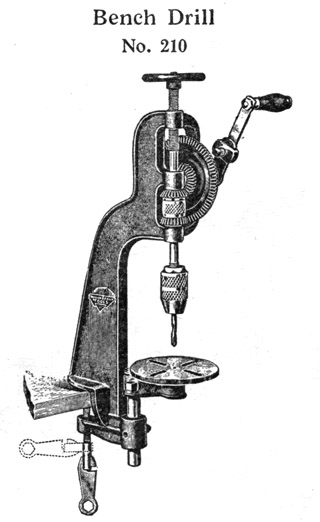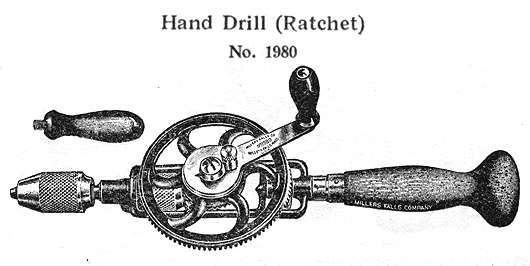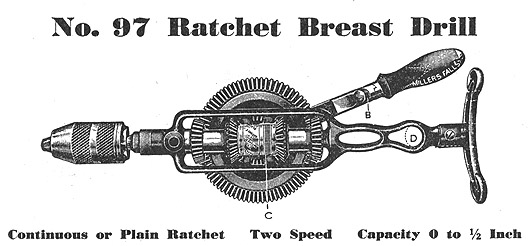Three of the bestselling drills of the Millers
Falls Co., Millers Falls, Mass., are known as their No. 210
Bench Drill, No. 1980 Hand Drill and No. 97 Breast Drill.
 The bench model is stated to be the largest
selling drill press of this type made by the company and it is a
thoroughly efficient tool sold at the reasonable price of $15,
which gives it unusual value.
The bench model is stated to be the largest
selling drill press of this type made by the company and it is a
thoroughly efficient tool sold at the reasonable price of $15,
which gives it unusual value.
It is a rigid, strongly, built, accurate
machine. This type is equipped with a hand feed that is
thoroughly adequate where the amount of drilling is not large
and is necessary in doing delicate work and where the speed of
feeding has to be constantly under strict control.
The speed of
this tool can be instantly changed by turning the knurled sleeve
and the ratios are from 1-1/2 to 1 and 4 to 1.
It has an extension crank from 3 to 6 inches
radius and is finished with a three-jaw Star chuck with
protected springs to hold around shanks up to 1/2 in.
The cast iron frame is unusually strong and
three frame bearings hold the drill spindle and feed screw.
A wrench is included to fit all nuts on the
tool, the overall length of which is 24 in., and the maximum
height 9 in.
The Model 1980 Ratchet is a large sized drill
with both a ratchet and change of speed.

It takes round shank drills up to 3/8 in., so it
can be used for many kinds of large drilling ordinarily done by
a breast drill, as well as the smaller drilling usually done by
a small hand drill.
The hollow handle end is of mushroom shape to
take the place of breast plate for use against the body. With
some mechanics and men who do not have a great difference in
work this one size of tool will serve every drilling purpose.
The ratchet makes it possible to work in cramped
places and the hollow end handle is quickly detached and will
hold twist drills up to the full capacity of the chuck. No
drills, however, are furnished with the tool.
The ratchet is shifted from right to left, or
vice versa, by giving a half turn to the cap of a small boss on
the crank handle. The speed is changeable by moving a knurled
barrel by pressure of the thumb and operates instantly without
any manipulation of the crank.
The gears are cut, the pinions being of steel
and enclosed for protection, and there is an equalizing bearing
to counter act the outward thrust of the larger gear, the ratios
of which are the same as the Model 210 Bench Drill.
This model is also equipped with a Star
three-jaw chuck and holds drills up to 3/8 in. The springs in
this chuck are located away down in the base where they cannot
be reached by the shank of a drill and jammed or knocked out of
place.
The illustration gives a good description of the
Model 97 Ratchet Breast Drill. This drill is especially popular
amongst automobile mechanics because of its straightening crank
and continuous ratchet which makes it possible to work in
practically any position.

This drill has an easily adjusted ratchet that
has five different actions:
-
The neutral position which gives the
drill the ordinary direct drive ratchet action;
-
Ordinary right hand action in which the
chuck stops turning on the backward stroke of the handle;
-
Ordinary left-hand ratchet action;
-
Continuous right-hand ratchet action in
which the chuck turns continuously to the right on both the
forward and backward strokes of the crank;
-
Continuous left-hand action.
The speed is instantly changeable without
removing drill from the work by moving the knob on the crank
handle. The gear ratios are even and 2-3/4 to 1. The fast and
slow speeds have separate bearings which greatly reduce the
friction and increase the power of the tool and there is also a
double gear drive resulting in very steady action.
All the gears have cut teeth and the small gears
are made of steel. In conjunction with the bearings there is a
take-up nut so that any wear in the bearings can be provided for
and further than this the fast and slow speeds are separated by
bushings so that one will not directly drag on the other.
The crank handle is adjustable for use as an
ordinary crank or as a straight lever for ratchet action in
cramped quarters or for putting greater power into the stroke
and is easily switched from one position to the other by a half
turn of the crank handle.
The breastplate is of special design to give a
handhold for steadying the tool in awkward and out-of-the-way
places. This action is performed simply by loosening a blind
screw and turning the plate parallel to the large gear. It is in
that position shaped to fit the hand and has a finger hole to
give an extra grip. A large auxiliary breast plate is provided
that can be easily clamped over the regular plate and gives
greater comfort and power for doing heavy work.
This drill also has the three-jaw chuck of Star
pattern well removed from any chance of jamming or being knocked
out of place, and will take drills up to 1/4 in.
Automobile Trade
Journal, Vol. 25, October 1920,
(Philadelphia: Chilton
Co.)
Related Info
Wiktor A. Kuc
December, 2016
We want to hear from you - write to:
info@wkFineTools.com
 The bench model is stated to be the largest
selling drill press of this type made by the company and it is a
thoroughly efficient tool sold at the reasonable price of $15,
which gives it unusual value.
The bench model is stated to be the largest
selling drill press of this type made by the company and it is a
thoroughly efficient tool sold at the reasonable price of $15,
which gives it unusual value. 
